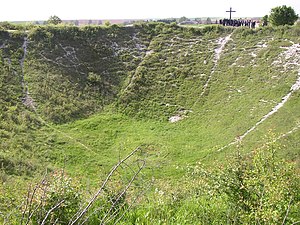Mine (siege): Difference between revisions
imported>Howard C. Berkowitz (New page: {{subpages}} <!-- Text is transcluded from the BASEPAGENAME/Definition subpage-->) |
George Swan (talk | contribs) (trim) |
||
| (One intermediate revision by the same user not shown) | |||
| Line 1: | Line 1: | ||
{{subpages}} | {{subpages}} | ||
< | [[File:Lochnagar Crater Ovillers.JPG | thumb | During [[World War I]] a tunnel was dug under [[German]] forces, and 30,000 pounds of explosive were detonated, leaving a massive crater.]] | ||
'''Mine''' (verb) is a military term for mounting a long term stealth attack on static enemies who are relying on fortifications to avoid a direct attack. | |||
During a [[seige]] an enemy force will surround a fortification, and try to force those within the fortification to surrender, by waiting them out. Seiges are more effective when you can cut off the fortification's supplies of water, or food, or both. | |||
Another technique - mining - calls on finding a way to covertly sneak a large supply of explosives underneath the fortification, and then detonating the explosion - perhaps coordinated with an above ground attack. | |||
If the fortification has unguarded [[sewers]] it may be possible to covertly place explosives within that sewer. | |||
If natural caves, or old mines go under, or near the fortification, it may be possible to covertly place explosives within that cave or mine. | |||
Finally, if a static battle goes on long enough, enemies may slowly dig tunnels intended to go under their enemies.<ref name=warhistoryonline2018-03-28/> | |||
==References== | |||
{{reflist|refs= | |||
<ref name=warhistoryonline2018-03-28> | |||
{{Cite web | |||
| url = https://www.warhistoryonline.com/world-war-i/gigantic-explosions-wwi.html | |||
| title = Gigantic Underground Mines – The Biggest Explosions of | |||
| date = 2018-03-28 | |||
| author = Sarah Cooper | |||
}} | |||
</ref> | |||
}} | |||
Latest revision as of 21:24, 5 January 2024

Mine (verb) is a military term for mounting a long term stealth attack on static enemies who are relying on fortifications to avoid a direct attack.
During a seige an enemy force will surround a fortification, and try to force those within the fortification to surrender, by waiting them out. Seiges are more effective when you can cut off the fortification's supplies of water, or food, or both.
Another technique - mining - calls on finding a way to covertly sneak a large supply of explosives underneath the fortification, and then detonating the explosion - perhaps coordinated with an above ground attack.
If the fortification has unguarded sewers it may be possible to covertly place explosives within that sewer.
If natural caves, or old mines go under, or near the fortification, it may be possible to covertly place explosives within that cave or mine.
Finally, if a static battle goes on long enough, enemies may slowly dig tunnels intended to go under their enemies.[1]
References
- ↑ Sarah Cooper (2018-03-28). Gigantic Underground Mines – The Biggest Explosions of.